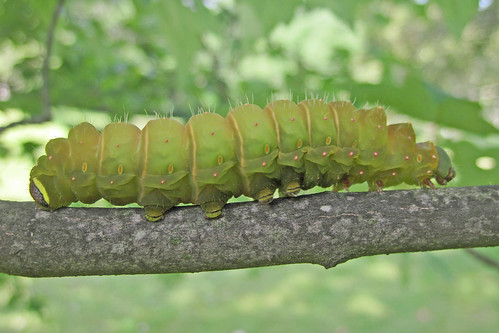There are few caterpillars more exiting to find than the
giant silkmoths. Their enormous size,
unique appearance, and amazing life history make them fascinating creatures to
study and observe. Their numbers can
fluctuate from year-to-year, and 2013 has been incredible for silkmoths. Last week’s discovery of two Cecropia Moth
caterpillars in the apple tree in the backyard at NBNC was definitely a
highlight.
 |
| Cecropia Moth caterpillar as it was found! |
The Cecropia is probably Vermont’s largest moth, and the
mature caterpillars are as long and wide as an index finger. They have an electric-lime body, covered in
colorful, spiky protuberances of orange, yellow, and blue. Despite their vivid appearance, they can blend
quite well into a leafy canopy. There
are, however, countless other creatures searching for these caterpillars with
the intent to cause them harm.
 |
| The two giant caterpillars feed in the apple tree |
 |
| Close-up of fly eggs |
When we think of caterpillar predators, we often picture
birds carrying a beak-full of caterpillars to hungry nestlings. It is other insects, however, which pose a
much more substantial threat to caterpillars.
The Cecropias we found at NBNC were both host to dozens of tachinid fly
eggs (the small, white ovals on the caterpillar’s back). The fly larvae will ultimately
kill and consume their caterpillar hosts.
 |
| We caught this tachinid fly laying eggs on the Cecropias |
The threat of six-legged predators has been compounded by
the introduction of a fly, Compsilura
concinnata, to the northeast in order to control the invasive gypsy
moth. This introduced fly has developed
a taste for more than just gypsy moths, and is thought to be playing a role in
the decline of the Cecropia and other giant silkmoths. Whatever the reason, silkmoths numbers have been
dropping for decades and the effects of this decline on other species are just
beginning to be understood.
While the adult giant silkmoths won’t fly again until next
spring, look for their giant caterpillars this summer and fall and share with
us what you find!
 |
| This Luna Moth caterpillar was also found last week at NBNC |

No comments:
Post a Comment